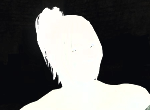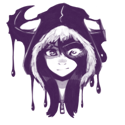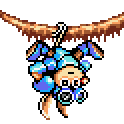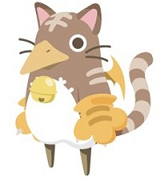|
Regarding your comment about christians in Japan during the shogunate: Christianity was introduced in 1549 by the Portuguese, but it was banned by the Japanese authorities. Refusing to renounce christianity (if you were Japanese) or trying to convert people to christianity was punishable by death until after the end of the shogunate in 1867. The Japanese Catholic Church went underground after a failed rebellion in the mid 1600's and had ~30 000 members at the time that the ban was lifted (not all of whom rejoined the Catholic Church). These days, ~1% of the population of Japan self identifies as christian. bpACH fucked around with this message at 00:05 on May 23, 2016 |
|
|
|

|
| # ? Apr 25, 2024 00:15 |
|
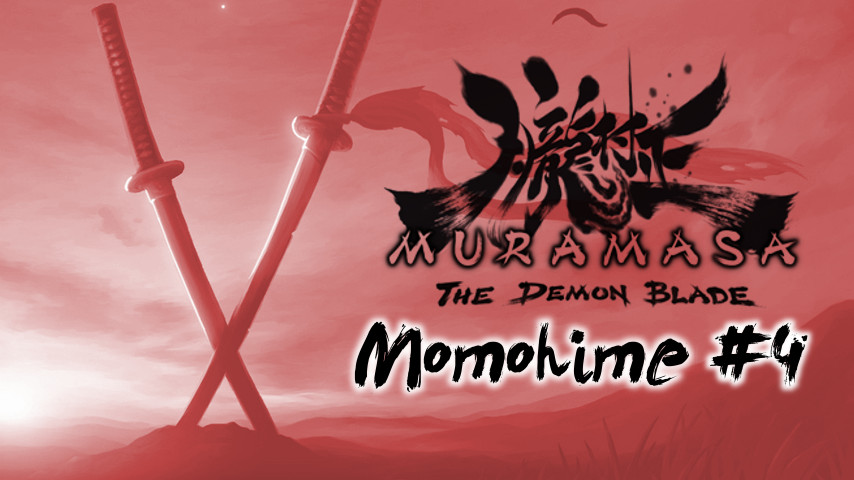 Help me figure out how to edit future vids for viewership convenience. Today we take a fun tour across midland Japan, learn about culture and fight a rad as poo poo boss. Also, odds are I'll have the first bit of history vids up this weekend since I found a good resource that talks about Yokai/Spirits. Also as a bonus, here's the songs from this episode that make me smile. Pretty sure someone else mentioned the songs here as well https://www.youtube.com/watch?v=wZb0k_-z00g https://www.youtube.com/watch?v=9t_IdRMe4CE bpACH posted:Regarding your comment about christians in Japan during the shogunate: Man, that's pretty rough. I wonder if the cross of souls is actually supposed to represent that or not? I was personally guessing. EponymousMrYar posted:Regarding Torahime's design, pay attention to what she (and Kisuke) say. She's leading ghost samurai to war against the shogun, atop a horse. Yeah I understand the motif. I just don't like the helmet specifically since it throws her design a bit off-balance imo. Could've made it like 20-30% smaller
|
|
|
|
I like the helmet. It implies she grabbed her Dad's armor all Mulan style.
|
|
|
|
Sengoku era and previous Samurai were archers first and foremost weren't they? I recall hearing something to the effect of bragging about your swordsmanship was a nasty self-burn because it meant you were such a pitiful archer you needed to close the distance. The whole Samurai-As-Swordsman thing was a post-gunpowder conceit. I can't cite a source on this - maybe it was the Civilopedia in Shogun: Total War.
|
|
|
|
It hasn't been brought up here, but one thing that's distinctive about spoken Japanese is that it's expected to change depending on several factors. These include your own gender, your age, your social postion within the conversation, and of course the same for your audience. Anyway, I'd heard via rumor that this comes up when Jinkuro possesses Momohime's body. Supposedly Momohime herself speaks in the expected style of a young and demure noblewoman, but Jinkuro-Momohime instead talks like a cantankerous old man (which obviously would be very strange for a young lady). Mind you, I've heard all this a few steps removed from the source, so it likely warrants further investigation. (I have zero training in the language, but I can summarize from Wikipedia.  ) )When both yams and sweet potatoes show up in the cooking, usually I would be wary considering that for years American supermarkets have convoluted the two products based on similarity of shape. (Nearly every product you can find on a shelf that talks about "yams" in such a place instead uses sweet potatoes. "Yamato" can refer to several things. Originally it just referred to the metropolitan area (if you could call it that) surrounding the city of Sakurai in south-central Japan. Eventually, given the city's relative prominence, Yamato also came to refer to the province itself. There's a period (of disputed length) in Japan's history in which the imperial court ruled from said province, establishing several palaces in the area during the 400s and 500s AD. And potentially because of this, it was also one of the ancient names of Japan itself. Stemming from a similar source ("yama" can refer in such contexts to mountains or forests), Wo or Yamato was used by 200s AD Chinese scholars to refer to the primary ethnic group of Japan in the same way that the primary ethnic group in China has for centuries been the Han. More precisely, there was a particular character which could be spoken as either name used to refer to Japan's ethnic majority, and due to the weirdness of logographic languages the latter spoken rendering likely had something to do with the once-imperial province. (Or maybe not; the chains of cause and effect are hard to puzzle together from summaries on Wikipedia but the sense I'm getting is that all of these did stem from a single source.) Anyway, because of this business with the Wo/Yamato character (which was eventually replaced by Japanese scholars who felt it demeaned them) "Yamato" eventually came to formally refer to the primary ethnic group in Japan in modern-day demographics and the like. Though if you do ever hear of "Yamato-damashii", be very wary. Literally it refers to the "Japanese spirit", but in practice it's been tied to right-wing Japanese nationalism (which is  -inducing crazypants/disturbing much of the time) since at least the Russo-Japanese War. -inducing crazypants/disturbing much of the time) since at least the Russo-Japanese War.
|
|
|
|
Skippy Granola posted:Sengoku era and previous Samurai were archers first and foremost weren't they? I recall hearing something to the effect of bragging about your swordsmanship was a nasty self-burn because it meant you were such a pitiful archer you needed to close the distance. The whole Samurai-As-Swordsman thing was a post-gunpowder conceit.
|
|
|
|
The Japanese name of the Cherry Blossom Blade isn't really "Sakura", but it does have "zakura" in it, so I'll let it slide. And since since you were asking about this a few episodes ago: the Japanese name of the Dark Resurrection Sword is 相模反魂黒光 "Sagami Hangon Kuromitsu".
|
|
|
|
The thing to remember regarding merfolk is that any culture with access to the ocean is going to have their own equivalent to it. For Japan, this would be the Ningyo: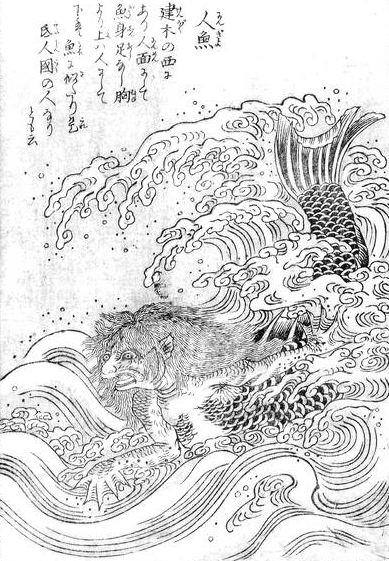 In terms of physical appearance they leaned more towards the fish end of the spectrum and were usually repulsive though more attractive ones were not unheard of, particularly following the end of the Edo period and the opening of Japan to the West as the more conventional mermaid elements that we're familiar with were introduced. The most unique attribute of the ningyo though is that their flesh is believed to grant eternal life and youth to those who eat it which is featured of many folk tales. Catching one was believed to bring storms and misfortune however, so fishermen who caught these creatures were said to throw them back into the sea and ningyo washing onto the beach was seen an omen of war or calamity. Chimera-gui fucked around with this message at 05:55 on Jul 28, 2016 |
|
|
|
FractalSandwich posted:The Japanese name of the Cherry Blossom Blade isn't really "Sakura", but it does have "zakura" in it, so I'll let it slide. Oh man thanks for bringing that up. I heard Kuromitsu in editing and wasn't sure if that was the sword. Confirmation helps a lot. Chimera-gui posted:In terms of physical appearance they leaned more towards the fish end of the spectrum and were usually repulsive though more attractive ones were not unheard of, particularly following the end of the Edo period and the opening of Japan to the West as the more conventional mermaid elements that we're familiar with were introduced. The most unique attribute of the ningyo though that their flesh is believed to grant eternal life and youth to those who eat it which is featured of many folk tales. Catching one was believed to bring storms and misfortune however, so fishermen who caught these creatures were said to throw them back into the sea and ningyo washing onto the beach was seen an omen of war or calamity. Kinda weird how this mystical creature's flesh brings about immortality, much like the nuppuppu and the more western-familiar Unicorn. I wonder if all mystical beings are potential immortality-burgers?
|
|
|
|
The whole ban on Christianity had some very interesting repercussions. See, one of the mechanisms the Tokugawa Shogunate used to keep control over the populace was family/household registries with local Buddhist temples. This wasn't attempting to use Buddhism to combat Christianity by any means, it was simply taking advantage of a resource that was already mostly in place. Anyway, local temples would have a record of every family from every nearby village. The idea is that this kept peasants rooted because they'd have to get their registry redone at the new temple, which wouldn't happen. In practice, it did happen but required approval of the temples and was generally a fuss if anyone got greedy and wanted a bribe, etc. A secondary purpose of the registry was to keep a look out on Christians. Basically, a Buddhist priest would personally confirm that your household was not a practicing Christian. In practice, there were numerous Christian groups that stayed hidden because they managed to stay in the good graces of their local temple. A lot of the time though, this practice meant a Buddhist priest could abuse the power they had. While it usually didn't lead to bringing down the Shogunate on not-Christians, it would lead to things like a recently deceased family member receiving a lovely slur or something impolite for their Buddhist name, and there were totally feuds between powerful households and temples because of this. Families of Shinto priests also had a lot of friction with less accommodating temples because only Buddhist priests could conduct funeral services, and they'd have to pretend to be Buddhist during the ceremony because nobody wants to ruin a funeral because they pissed off the priest. Largely though, the anti-Christianity stuff had more to do with Christianity no longer being a useful tool. During the Sengoku period, it was often useful because the Jesuits were well-trained and provided useful services. Hideyoshi tried to curry the favor of Christians to get the Portuguese to lend him their ships to use for the invasion of Korea. But under the Tokugawa, there was no use. Christianity was simple a lever the Shogunate didn't have a hand on, so they tried to bury it.
|
|
|
|
Lazy Bear posted:Correct, though I also can't cite a source. Fact of is that you don't put nobility(as Samurai were) on the frontlines with a melee weapon. They're kind of entirely too valuable. The katana/tachi was a backup weapon and a symbol. It's been some time since I read up on the subject, so my recollection is almost certainly somewhat in error, but if I'm not very much mistaken the samurai prior to the Shogunate were less like a noble class and more like landed mercenaries. Then again, it has been some time, and the primary thing spurring this is a possibly false memory of reading somewhere that the Sengoku Jidai essentially occurred (or at least started) because the Emperor couldn't pay the Samurai for a battle. Edit: In retropsect it's been too long and I can't corroborate my memory with anything so it's probably off. Never mind. MShadowy fucked around with this message at 05:16 on May 25, 2016 |
|
|
|
So, first, the movie you were thinking of with the fake money was Pom Poko. It's about tanuki, and during one scene one of them tries to pass off a transformed leaf as money to another tanuki. He gets berated for it. "We don't do that anymore," basically. There was a fox spirit involved as well, but he took a much more commercial attitude to human life than the tanuki who just wanted their home saved. Anyway. Tsunayoshi Tokugawa is known for, among other things, the Laws of Compassion. These attempted to reduce suffering by punishing various forms of violence, including those towards children and dogs. Certain mistreatments of dogs were punishable by death. These were considered very extreme for the time, and he didn't have a very good reputation as a result. I'm hardly a strong scholar of this sort of history so hopefully someone else can fill in the gaps better. But either way, a boar is not a dog, so Jinkuro'd be fine killing Izasaou, is what that line was about. Ippon-datara is an oddball one. It's a bit of folklore about some giant being with a single foot. The name literally means "one foot-bellows," as in the thing you would see in an old blast furnace driven by several people at once pressing with their feet, as a see-saw. But the name has some heavy word-play to it. Unless I'm mistaken, normally you would count a bellows with 台, "dai", the counter for machines and such; accordions are counted with this, so bellows should be. What you would count "ippon" 一本 would be cylindrical objects, such as books (think scrolls), or legs. So, you get a giant with one foot so big, he could drive a blast furnace bellows by himself. The role of ippon-datara in a story varies, but they're generally vengeful giant mountain spirits. It makes sense Izasaou would turn into one to scare people off. (slightly edited above because I forgot to explain the books = cylinders thing properly. Akujiki's linked an article about the tatara furnace below.) Goggle Fox fucked around with this message at 15:12 on May 25, 2016 |
|
|
|
MShadowy posted:It's been some time since I read up on the subject, so my recollection is almost certainly somewhat in error, but if I'm not very much mistaken the samurai prior to the Shogunate were less like a noble class and more like landed mercenaries. Yes and no. What would eventually become the samurai we know had its roots in two interlinked groups. Basically, it wasn't all that uncommon for the Emperor or his relatives to have sons. And you really don't want too many sons with too much time on their hands and nothing to do, because they might get dangerous ideas. What happened was a lot of these sons were given the surname Taira or Minamoto, cutting them off from their divine heritage, and sent away from the capital. It can be extremely confusing because although the Taira and Minamoto clans are recognized as two clans, the imperial family kept having unwanted sons they kept naming Taira or Minamoto. The result is that you'd have a Minamoto bushi who descended from one such ex-prince alongside an ex-prince who was recently a member of the imperial household. There's quite a lot of interclan feuding and such because of that. The other group are powerful rural households. They're distant enough from Heian-kyo to more or less run local affairs on their own, including the military. Hunting on horseback with bows was part of their military training. Shockingly, some Taira and Minamoto cozied up with households and assimilated. Fast forward a hundred years or so and you have a bunch of guys with bows and horses who could fight and have some vague ties to the imperial household. And they'll totally serve as mercenaries. It's not the same as the samurai under the Tokugawa but the Taira and Minamoto did originate from nobility, and many famous warlords of the Sengoku Jidai were, in turn, descendants of the Taira and Minamoto.
|
|
|
|
Something I'd like to add to my vote for cutting the videos: Please show the area map at some point. I'd like to have at least some idea about how the area is structured and where all these places are you actually show off.
|
|
|
|
Travelogues! Kai: One of the original provinces established in the Nara Period (710-794) when the capital was, as you might imagine, in Nara. Now a part of Yamanashi Prefecture, it was at one point ruled by the Minamoto family, and then the Takeda family, including Shingen Takeda, whose territory also contained Shinano, which we'll talk about in a bit. It was also situated in a good position to defend Edo from two major access points. Shinano: Part of modern-day Nagano Prefecture, was also ruled by Shingen. Hida: Honestly, nothing really of note to this place. It's now modern-day Gifu Prefecture. The most interesting thing I could find was that it used to be written 斐太 and there's a high school in the region named for it. Sweet potatoes: Takibi (bonfires) are pretty popular, though they takes a variety of forms. About four years ago during the winter I was running, and came across a couple of my students and their families outside cooking sweet potatoes on a bonfire. It's a kind of winter comfort food. Music: I was the one who mentioned Seasonal Beauties and what it means. Shamisen (this in particular is likely Tsugaru jamisen) are such a beautiful and unique instrument that add a fantastic layer, due to featuring both plucking and percussive instrumentation. They're very versatile instruments, capable of finding niches in both very classical Japanese music as well as modern arrangements. Ippondatara: A pretty well-known youkai, though there are a variety of interpretations of it. Generally speaking, it has one eye and one leg. Because of the name association with furnaces, there are also views that Ippondatara is actually Ame no Mahitotsu no Kami, the mythological god of blacksmiths, fallen from his station.
|
|
|
|
Akujiki posted:Ippondatara: A pretty well-known youkai, though there are a variety of interpretations of it. Generally speaking, it has one eye and one leg. Because of the name association with furnaces, there are also views that Ippondatara is actually Ame no Mahitotsu no Kami, the mythological god of blacksmiths, fallen from his station. Ah, hadn't run into that. Makes a lot of sense, and well, that'd be quite a fall, from forging the imperial treasures. Just to double check, since I was shaky on what word to use for a tatara, did the counting word choice I had make sense? Not that you'd likely have to count them day to day.
|
|
|
|
Skippy Granola posted:Sengoku era and previous Samurai were archers first and foremost weren't they? I recall hearing something to the effect of bragging about your swordsmanship was a nasty self-burn because it meant you were such a pitiful archer you needed to close the distance. The whole Samurai-As-Swordsman thing was a post-gunpowder conceit. It'd make sense, more than often the success of wars have been tied to the evolution of ranged combat over martial. If you want to see a neat depiction of a historical battle, Crecy (by warren Ellis) was a comic describing the life and trials of English Longbowmen during the wars of the medieval era and also brings up a good commentary on the romantization of the life of Knights and their like. Granted this is a totally different area but I'd imagine for japan the mindset was the same, hell they had a developed archery style that guaranteed accuracy if you did the stance right.
|
|
|
|
Goggle Fox posted:Ah, hadn't run into that. Makes a lot of sense, and well, that'd be quite a fall, from forging the imperial treasures. That sounds correct. On further reading, I've scrounged up a bit of information that's quite interesting. Ippondatara is generally described, by legends in Wakayama and Nara, as appearing in the mountains only on December 20th. Coincidentally, there's also a large wild boar that was killed by hunters, returned as a spirit that attacked travelers in the guise of a demon with one leg, and was sealed by a priest, with the seal only weakening on one single day - December 20th. The boar's name? Inosasaou.
|
|
|
|
 Today we fight Tengu! Lots and LOTS of tengu. Also crows.
|
|
|
|
Some corrections since I wasn't clear about my previous info. Christianity enters during the Sengoku Jidai. At this time, it is still the Ashikaga Shogunate (mostly in name). It is under Hideyoshi that he attempts to curry favor with the Portugese to use their carracks to aid in the invasion of Korea (1592-98). Leading up to the invasion, he has a careful balancing act. Previously, it wasn't uncommon for daimyos to convert to Christianity in order to curry favor with the Jesuits and their resources. The Society of Jesus (to which Jesuits belonged) stood out because its members were educated and trained. Their strategy for conversion was targeting leaders and the educated elite, top-down conversion rather than trying to get to the masses. In Japan, what often happened was that a daimyo would convert, then order his retainers to convert, and so on and so forth until the peasants were converted as well. Of course, if they were forced into it, then they probably weren't true believers. Anyway, Hideyoshi became aware that Christianity was often used to soften up foreign nations by the Catholic nations from the wild claims of a shipwrecked Spanish captain. On one hand, he wanted to curb the influence of the Christians in Japan but he still believed he needed the aid of the Portuguese. He issued a decree against Christianity and it was never really enforced because he didn't want to piss off the Portugese. Plus, many Christian daimyo took part in the invasion of Korea. After the invasion didn't go well, he did start purging Christians but it wasn't as thorough or widespread as it was under the Tokugawa. While I'm still talking about Toyotomi Hideyoshi, he and Oda Nobunaga were never shogun. It is a title conferred by the Emperor. As for why they weren't shogun, Nobunaga defied a lot of traditions and conventions, and it's theorized he avoided taking the title because he had no need for someone else to declare him anything. Hideyoshi was of common birth rather than being a descendant of the Taira or Minamoto, so he couldn't receive the title. He did get adopted into the Fujiwara and was the Imperial Regent and chancellor though. It's Tokugawa Ieyasu that becomes shogun and it's under the Tokugawa shogunate that Christianity becomes banned in 1614. Around the same time, the Buddhist registry becomes used to root out Christians (as well as people who aren't where they should be).
|
|
|
|
I always get a chuckle out of Japanese media which depicts Tokugawa as remotely heroic, because he was pretty much the most awful actor of the whole drama who instituted a brutal and repressive regime.
|
|
|
|
That's just history for you. Nobunaga tends to get a bad rap because he was brutal and broke convention. But he also fostered trade and tried to break the back of old power structures that kept Japan from centralizing. Hideyoshi's invasion of Korea was pretty stupid and disastrous for the people of Korea. However, he largely continued Nobunaga's policies and he tends to get poked fun at for being a commoner. I guess the best thing to say about Tokugawa was that he definitely ended the Sengoku Jidai under his shogunate.
|
|
|
|
Regarding sword durability: Looks like all your swords got the increased durability regen, it's just that naturally the first sword that breaks has already done some recharging so it recharges first. Also while Sayo could indeed be a boss fight for both Momohime and Kisuke (for the same reasons actually) Ippondatara wouldn't really cut it as a Kisuke boss. Why would he spare the pig spirit after it tried to kill him? It' doesn't make sense for him. Regarding the reasoning Sayo attacks Kisuke and calls him possessed by a malicious and hateful spirit: don't forget you're carrying around Muramasa blades, which are forged out of souls which fuel fires of hate (not to mention somehow carting the spirit of Muramasa around himself.) That certainly fits the bill  However that does make Sayo inconsistent regarding the two of them. There's only two reasons I can think of (ignoring the Muramasa thing entirely) that explain her actions and allow her to remain consistent in the way she treats both protagonists: 1. Jinkuro knows how to hide from most Buddhist priests considering he's done this soul transfer thing a lot while Oburo straight up fused himself with Kisuke and quasi-removed himself from existence. 2. Sayo's statement is colored by her assumptions. Heck, Oboro straight up says that Soul Fusion is Demonic and a big no-no to Buddhism, which would make Kisuke's spirit evil in her eyes. Considering his brusque and rude mannerisms that could be construed as malice/hate, since heck, he's already evil might as well pile on the pejoratives. Supplementary there's also the whole thing about the Oboro style being accursed by Sayo's account. That could have something to do with it too. It's a pet annoyance of mine when people forget that characters in fiction can be allowed to be characters and thus do not have to speak/convey facts with 100% accuracy.
|
|
|
|
The two main variants of tengu are the Ko tengu, also called the Karasu tengu, and the Dai tengu which may or may not also be known as the Hanataka tengu (I got conflicting info on this one) which are higher on the hierarchy than ko tengu. Ko tengu are typically more bird-like while Dai tengu are much more humanoid with long noses and will usually have red skin as well.
|
|
|
|
Gosh, I love that Jinkuro is actually just a huge softie. I mean aside from the cold-blooded body theft.
|
|
|
|
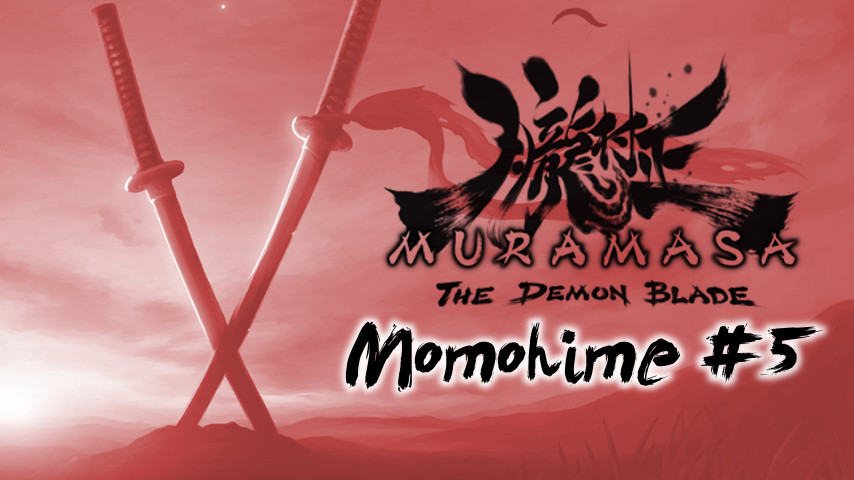 Normally I'm energetic about the game, but this is honestly the overall low-point. Pardon my cynicism.
|
|
|
|
On the hot spring: I think I'd agree about character development in the hot springs if either Kisuke or Momohime knew each other. They don't, and since in the hot springs you're Momohime and not Jinkuro-Momohime, there's no real reason to expect a princess to talk shop with some random guy in a hot springs when she's already freaking out about him being there in the first place. On the chimera: This is an actual thing. Monkey's head, tanuki's body, tiger's limbs, snake's tail. There's an amusing moment in a chapter in Heike Monogatari where a chimera appears to terrorize an imperial party. A magistrate puts Minamoto Yorimasa in the hot seat. Heike Monogatari posted:"Yorimasa is the one who can eliminate this monster."
|
|
|
|
Akujiki posted:On the chimera: This is an actual thing. Monkey's head, tanuki's body, tiger's limbs, snake's tail. There's an amusing moment in a chapter in Heike Monogatari where a chimera appears to terrorize an imperial party. A magistrate puts Minamoto Yorimasa in the hot seat. Funnily enough, this particular chimera is actually known as a nue.
|
|
|
|
On the topic of the scene with Echigoya and Danjo Shikami, this is apparently a reference to a stock scene and/or other references to that stock scene in Japanese fiction. "Echigoya" in particular is the default name for the Shady Merchant in the scene, so I'm not surprised that he never shows up again.quote:The past few times I've tried to post this, I've gotten all tangled up in the story and bailed out. If you're reading this, it means I've finally managed to straighten it all out (more or less) and you are about to learn the shocking facts of
|
|
|
|
 One of my favorite chapters from a storytelling and mechanical design standpoint. Let's fight some creepy-rear end spiders! also special episode 1 is being edited, should be up tomorrow or with the next episode.
|
|
|
|
In some circles of Buddhism, reincarnation is not immediate but instead occurs after a wait of 49 days in some intermediate state between death and life. (Tibetan Buddhism in particular refers to such a state as the "bardo".) Additionally, it happens to be the number of days and nights that Siddhartha Gautama sat in meditation before achieving enlightenment, so in this case such a number has a dual purpose. The old monk's comments obviously allude to the former (as he's concerned that Torahime would otherwise be shortly reincarnated), while Torahime herself speaks of some reprieve by the Buddha alluding to the latter. You didn't mention it on the video, but there's one aspect of Torahime's attire that bears mention nonetheless. Notice how one arm is bare, while her other arm is clothed with some sort of gauntlet? (Which arm is which isn't constant throughout the video, but I presume that's just a result of sprite limitations.) That's a standard style of dress for archers, at least when one's clothing is otherwise loose. Generally your arm holding the bow would be bare so that the released bowstring wouldn't catch on anything, which might injure you and/or throw off the shot. In contrast your draw arm wouldn't have such issues for the most part, except for your draw hand. Holding and then releasing a bowstring tends to be very damaging to the fingers if you aren't protecting them in some way, and thus there exist numerous examples of protective equipment such as finger tabs (for a three-fingered Mediterranean draw) or thumb rings (for a thumb-based Mongolian draw) to ensure that something else takes the brunt of a bowstring moving at over a hundred feet per second. In particular, Japanese-style archery (kyudo) employs a three- or four-fingered deerskin glove known as a yugake.
|
|
|
|
NGDBSS posted:Which arm is which isn't constant throughout the video, but I presume that's just a result of sprite limitations. It's common to just flip a sprite to avoid having to make two different ones (one facing left while the other faces right). However, this creates problems for asymmetrical characters like our dead tiger princess as details get flipped around every time the character changes direction.
|
|
|
|
It's the same thing between the two versions, basically, but the Vita version is using Latin. So Arachnida Interficere roughly translates to Spider Destroyer/Killer.
|
|
|
|
Chimera-gui posted:It's common to just flip a sprite to avoid having to make two different ones (one facing left while the other faces right). However, this creates problems for asymmetrical characters like our dead tiger princess as details get flipped around every time the character changes direction. Actually one of the neat things that this game has been doing has been showing the characters changing their details naturally when they flip. Torahime moves her bow from one hand to the other (which also disguises her flip) Momohime had that interstitial frame showing her doing the same with her sword, Kisuke does it too, so there's a bit more effort than just flipping the sprites and calling it a day (even though they do so copiously, IE Hot Springs Momohime.) It's kind of a limitation of the format, but I still think the changing-hands details are neat and make things less confusing. EponymousMrYar fucked around with this message at 01:20 on Jun 5, 2016 |
|
|
|
That's the real reason the Oboro style is so rare - you can't use it unless you're ambidextrous.
|
|
|
|
EponymousMrYar posted:Actually one of the neat things that this game has been doing has been showing the characters changing their details naturally when they flip. Torahime moves her bow from one hand to the other (which also disguises her flip) Momohime had that interstitial frame showing her doing the same with her sword, Kisuke does it too, so there's a bit more effort than just flipping the sprites and calling it a day (even though they do so copiously, IE Hot Springs Momohime.) Changing which hand is holding your weapon I understand but having gloves, sleeves, and the like change sides for no reason a little less acceptable since it's still lazy.
|
|
|
|
Chimera-gui posted:Changing which hand is holding your weapon I understand but having gloves, sleeves, and the like change sides for no reason a little less acceptable since it's still lazy. There are many adjectives I could use to describe the spritework in this game. "Lazy" is not one of them.
|
|
|
|
Chimera-gui posted:Changing which hand is holding your weapon I understand but having gloves, sleeves, and the like change sides for no reason a little less acceptable since it's still lazy. Honestly, you're kinda missing the forest for the trees in a way. The game is hand-animated for every single frame with a staggering amount of detail and shading. This demanded a lot of man-hours, especially when during the dev cycle of this game the CEO of vanillaware was 20 million yen in debt. A small and acceptable sacrifice for the overall picture.
|
|
|
|
Chimera-gui posted:Changing which hand is holding your weapon I understand but having gloves, sleeves, and the like change sides for no reason a little less acceptable since it's still lazy. Hence why it's more a limitation than lazyness in this case because they did put in the effort to do the hand-swapping. That's significantly more effort than others have put in (and something of a hallmark of their 2d stuff.) EponymousMrYar fucked around with this message at 04:00 on Jun 5, 2016 |
|
|
|

|
| # ? Apr 25, 2024 00:15 |
|
EponymousMrYar posted:There's not a whole lot you can do about that, since animating/having opposite asymmetrical sprites complete with animations would take time. It's realism sacrificed for gameplay. That's fair, but this is the kind of thing that wouldn't be accepted if there weren't the financial issues Vanillaware was having at the time since in other situations it would be seen as laziness.
|
|
|








